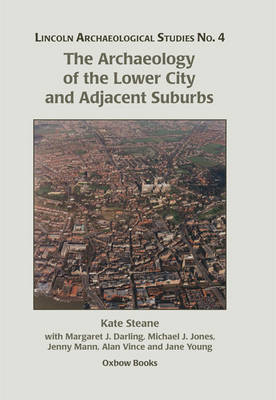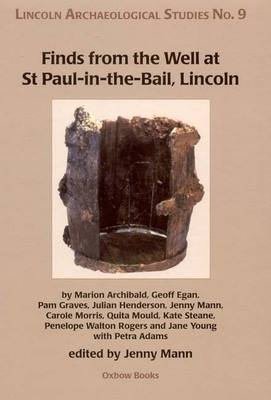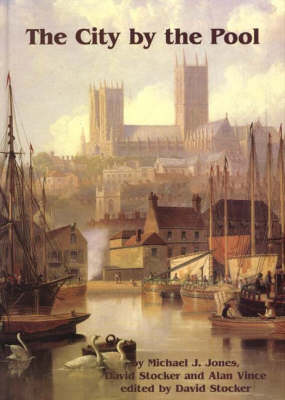Lincoln Archaeology Studies
6 primary works
Book 2
Archaeology of Wigford and the Brayford Pool
by Kate Steane, Margaret Darling, Jenny E. Mann, and Alan G. Vince
Published 1 April 2001
The suburb of Wigford lies near the heart of the historic city of Lincoln. Before excavations began in 1972, nothing was known of the prehistory of the area and so the arrival of the Roman army represented the first historic event. This volume publishes the results of the excavation of several sites, made possible by a series of urban development schemes. Each of the excavations differed in the extent and depth of the stratigraphy uncovered and each belonged to a different period, from the Iron Age to post-medieval.
Book 4
The Archaeology of the Lower City and Adjacent Suburbs
by Kate Steane, Margaret Darling, Michael J. Jones, Jenny Mann, Alan Vince, and Jane Young
Published 29 February 2016
This volume contains reports on excavations undertaken in the lower walled city at Lincoln, which lies on sloping ground on the northern scarp of the Witham gap, and its adjacent suburbs between 1972 and 1987, and forms a companion volume to LAS volumes 2 and 3 which cover other parts of the historic city. The earliest features encountered were discovered both near to the line of Ermine Street and towards Broadgate. Remains of timber storage buildings were found, probably associated with the Roman legionary occupation in the later 1st century AD. The earliest occupation of the hillside after the foundation of the colonia towards the end of the century consisted mainly of commercial premises, modest residences, and storage buildings. It seems likely that the boundary of the lower enclosure was designated before it was fortified in the later 2nd century with the street pattern belonging to the earlier part of the century. Larger aristocratic residences came to dominate the hillside with public facilities fronting on to the line of the zig-zagging main route. In the 4th century, the fortifications were enlarged and two new gates inserted. Examples of so-called ‘Dark Earth’ deposits were here dated to the very latest phases of Roman occupation.
Elements of some Roman structures survived to be reused in subsequent centuries. There are hints of one focus in the Middle Saxon period, in the area of St Peter’s church, but occupation of an urban nature did not recommence until the late 9th century with the first phases of Anglo-Scandinavian occupation recorded here. Sequences of increasingly intensive occupation from the 10th century were identified, with plentiful evidence for industrial activity, including pottery, metalworking and other, crafts, as well as parish churches. Markets were established in the 11th century and stone began to replace timber for residential structures from the mid-12th century with clear evidence of the quality of some of the houses. With the decline in the city’s fortunes from the late 13th century, the fringe sites became depopulated and there was much rebuilding elsewhere, including some fine new houses. There was a further revival in the later post-medieval period, but much of the earlier fabric, and surviving stretches of Roman city wall, were swept away in the 19th century.
Elements of some Roman structures survived to be reused in subsequent centuries. There are hints of one focus in the Middle Saxon period, in the area of St Peter’s church, but occupation of an urban nature did not recommence until the late 9th century with the first phases of Anglo-Scandinavian occupation recorded here. Sequences of increasingly intensive occupation from the 10th century were identified, with plentiful evidence for industrial activity, including pottery, metalworking and other, crafts, as well as parish churches. Markets were established in the 11th century and stone began to replace timber for residential structures from the mid-12th century with clear evidence of the quality of some of the houses. With the decline in the city’s fortunes from the late 13th century, the fringe sites became depopulated and there was much rebuilding elsewhere, including some fine new houses. There was a further revival in the later post-medieval period, but much of the earlier fabric, and surviving stretches of Roman city wall, were swept away in the 19th century.
Book 6
A Corpus of Roman Pottery from Lincoln
by Margaret Darling and Barbara Precious
Published 22 November 2013
This is the first major analysis of the Roman pottery from excavations in Lincoln (comprising more than 150,000 sherds). The pottery is presented in seven major ware groups. Fine wares include a modest range of imports and are dominated by Nene Valley products. Oxidised wares are mostly local products with a few imports as are the shell- and calcite-tempered wares and reduced wares. The final three are the standard specialised wares: mortaria, mostly of German and Mancetter-Hartshill manufacture; amphorae (80% Spanish Dressel 20) and samian, mostly from Les Martres/Lezoux and 75% undecorated! The discussion explores the chronological range of the entire ceramic assemblage across the three discrete parts of the Roman fortress and later colonia.
Book 7
A Corpus of Anglo-Saxon and Medieval Pottery from Lincoln
by Jane Young, Alan G. Vince, and Victoria Naylor
Published 20 February 2006
Lincoln was the centre for a large Medieval pottery industry which flourished from the 9th to the 15th century. Pottery produced in Lincoln was traded over a large part of the east midlands and beyond - even as far as Birka in Sweden. Despite the presence of this local industry, pottery produced in the surrounding areas - such as Torksey, Stamford, Potterhanworth, Toynton and Bolingbroke - accounted for a large share of the pottery used within the city of Lincoln itself. This volume reports on the Anglo-Saxon and Medieval pottery found during various archaeological excavations in the city from 1970 until 1987. The authors present a city-wide pottery classification system and analyse the sequence of pottery types through time and at numerous sites. They make extensive use of petrological analysis, including the study of over 600 thin-sections. These have been used to characterise the local clay and temper sources exploited by Lincoln potters and to identify wares made in the vicinity of the city, those made elsewhere in the county of Lincolnshire, and to identify regional and foreign imports. The volume is arranged by pottery types, illustrated by typical and unusual examples and accompanied by descriptions of their visual appearance, petrological characteristics, source, forms, decoration and dating evidence.
Book 9
This report examines the finds from the 17th-century backfill of a well in the churchyard of St. Paul-in-the-Bail. Dug possibly as early as the 1st century, the well lay within the east range of the later forum , and may have been used subsequently as the baptistry of two successive early churches, built some time between the late 4th and 7th centuries. The history and use of the well is briefly outlined, with the focus of the volume on the finds. The assemblage from the 17th-century backfill represents the largest group of artefacts of this period to have been recovered in the city of Lincoln and contains a high proportion of organic material. The artefacts show a wide range in type and quality, including both common household articles and items indicating a relatively high social status. Selected finds are catalogued, primarily by function.
Book 10
There are two aspects to this huge publication. It is firstly a comprehensive synthesis of the information from excavations and building surveys in and around Lincoln, which endorses some established ideas but also proposes exciting new ones: the ritual nature of the area in the late Bronze and Iron Age, and its effect on the Roman occupation; a Saxon settlement and market site; the layout of medieval markets around the ecclesiastical centre; the development of settlements on the valley floor; a concentration of early Dissenting communities within the city; and, the growth of industrial Lincoln from the 1840s onwards. This review is extensively illustrated by lots of figures and photos and newly-drawn maps and plans. Behind the synthesis is LARA, the Lincoln Archaeological Research Assessment, a relational database of the city's archaeology, which is maintained by the city's Planning Department, and is included here in GIS form on a CD-Rom. For any spot within the city it will tell you what is known archaeologically and, more importantly, what questions need to be answered about the area. It is both a Research Assessment tool and a Planning tool.
The book is the last word in Urban Archaeological Assessment and it will be of interest to archaeologists and planners far beyond the boundaries of Lincoln.
The book is the last word in Urban Archaeological Assessment and it will be of interest to archaeologists and planners far beyond the boundaries of Lincoln.





